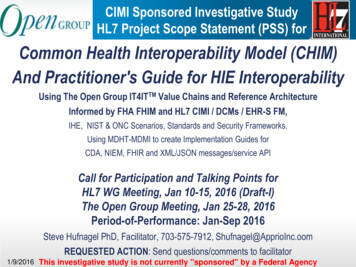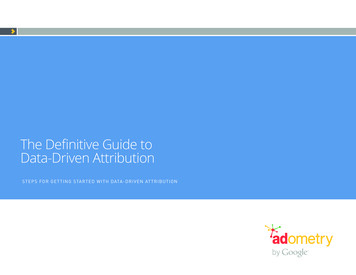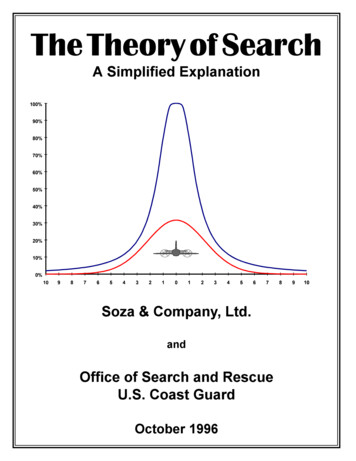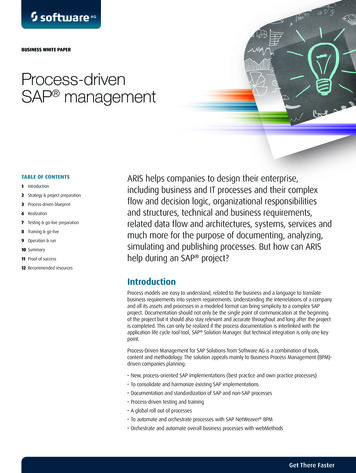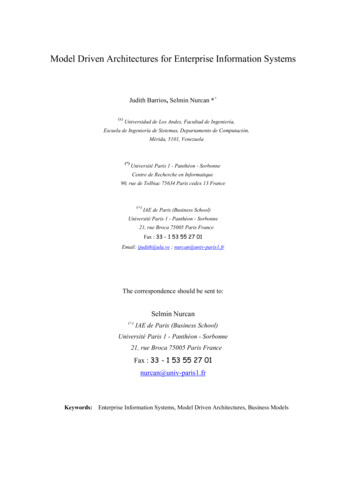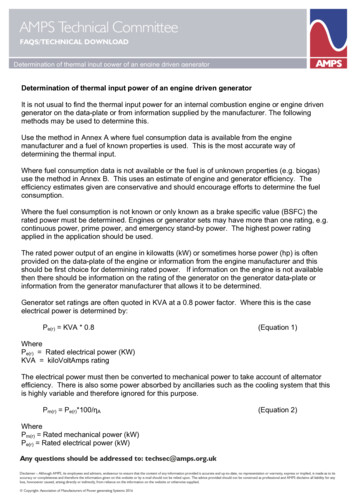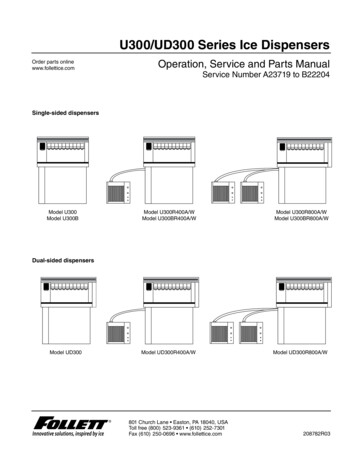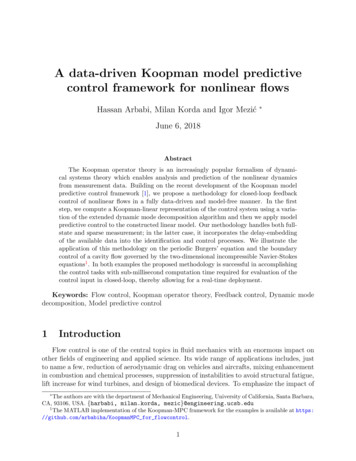
Transcription
A data-driven Koopman model predictivecontrol framework for nonlinear flowsHassan Arbabi, Milan Korda and Igor Mezić June 6, 2018AbstractThe Koopman operator theory is an increasingly popular formalism of dynamical systems theory which enables analysis and prediction of the nonlinear dynamicsfrom measurement data. Building on the recent development of the Koopman modelpredictive control framework [1], we propose a methodology for closed-loop feedbackcontrol of nonlinear flows in a fully data-driven and model-free manner. In the firststep, we compute a Koopman-linear representation of the control system using a variation of the extended dynamic mode decomposition algorithm and then we apply modelpredictive control to the constructed linear model. Our methodology handles both fullstate and sparse measurement; in the latter case, it incorporates the delay-embeddingof the available data into the identification and control processes. We illustrate theapplication of this methodology on the periodic Burgers’ equation and the boundarycontrol of a cavity flow governed by the two-dimensional incompressible Navier-Stokesequations1 . In both examples the proposed methodology is successful in accomplishingthe control tasks with sub-millisecond computation time required for evaluation of thecontrol input in closed-loop, thereby allowing for a real-time deployment.Keywords: Flow control, Koopman operator theory, Feedback control, Dynamic modedecomposition, Model predictive control1IntroductionFlow control is one of the central topics in fluid mechanics with an enormous impact onother fields of engineering and applied science. Its wide range of applications includes, justto name a few, reduction of aerodynamic drag on vehicles and aircrafts, mixing enhancementin combustion and chemical processes, suppression of instabilities to avoid structural fatigue,lift increase for wind turbines, and design of biomedical devices. To emphasize the impact of The authors are with the department of Mechanical Engineering, University of California, Santa Barbara,CA, 93106, USA. {harbabi, milan.korda, mezic}@engineering.ucsb.edu1The MATLAB implementation of the Koopman-MPC framework for the examples is available at https://github.com/arbabiha/KoopmanMPC for flowcontrol.1
flow control, it is worth noting that discovery of efficient flow control techniques for reductionof drag on ships and cars can result in mitigation of yearly CO2 emission by millions of tonsand annual savings of billions of dollars in the global shipping industry [2, 3].Despite all the interest and continuous effort, the flow control still poses a dauntingchallenge to our theoretical understanding and computational resources. The main sourceof difficulty is the combination of high-dimensionality and nonlinearity of fluid phenomenawhich results in computational or experimental models which are too complex and costlyto control using well-developed strategies of modern control theory. The recent advances innumerical computation has led to partial success with active control of flows using modelsbased on Navier-Stokes equations [2, 4–6]; however, these methods suffer from two majorshortcomings: first, nonlinear models obtained from Navier-Stokes are still high-dimensionaland computationally costly, thereby not allowing for fast implementation of nonlinear andcomputationally complex control techniques such as nonlinear model predictive control, andsecond, linear models used with LQR/LQG or adjoint-based controllers often rely on locallinearization around equilibria or a trajectory of the flow which makes them valid only locally,and may result in suboptimal or even unstable control performance.An alternative approach that has gained traction in the last two decades is identificationof relatively low-dimensional flow models from data provided by numerical simulations or experiments. Some of the data-driven methods combine the measurement data with underlyingphysical model to identify models of the system. The major examples include construction of(usually autonomous) state space models via Galerkin projection of the Navier-Stokes equations onto the modes obtained by proper orthogonal decomposition (POD) of data [7–9], oridentification of linear input-output systems using balanced POD [10, 11]. There are also afew applications of system identification methods to construct linear input-output modelspurely from data, including the eigensystem realization algorithm [12, 13], as well as subspace identification and autoregressive models [14, 15]. Utilization of the above techniquesin a variety of problems has shown great promise for low-dimensional modeling and controlof complex flows from data.In this paper, we present a general and fully data-driven framework for control of nonlinear flows based on the Koopman operator theory [16,17]. This theory is an operator-theoreticformalism of classical dynamical systems theory with two key features: first, it allows a scalable reconstruction of the underlying dynamical system from measurement data, and second, the models obtained are linear (but possibly high-dimensional) due to the fact that theKoopman operator is a linear operator whether the dynamical system is linear or not. Thelinearity of the Koopman models is especially advantageous since it makes them amenableto the plethora of mature control strategies developed for linear systems. This frameworkfor design of controller, is called Koopman-MPC and follows the work in [1]. In the firststep of our approach, we build a finite-dimensional approximation of the controlled Koopmanoperator from the data, using a variation of the extended dynamic mode decomposition algorithm (EDMD) [18], with a particular choice of observables assuring linearity of the resultingapproximation. The ideal data would include measurements on a number of system trajectories with various input sequences. In the second step, we apply the model predictive control(MPC) to these linear models to obtain the desired objectives. The distinguishing feature isthat this framework leads to a linear MPC, solving a convex quadratic programming problem, and thereby enables a rapid solution of the underlying optimization problem, which is2
necessary for real-time deployment. This methodology can be also applied to problems withsparse measurements, i.e., problems with a limited number of instantaneous measurements(e.g. point measurements of the velocity field at several different locations). In that case,delay-embedding of the available measurements (and nonlinear functions thereof) is used toconstruct the Koopman-linear model; the MPC is then applied to the linear system whosestate variable is the delay-embedded vector of measurements.The outline of this paper is as follows: A brief review of related work is given in section 1.1.Section 2 gives a review of the Koopman operator theory for dynamical systems with input.In section 3, we describe the EDMD algorithm for construction of the Koopman-linear modelfrom measurement data. In section 3.1, we discuss using delay-embedding to constructand control Koopman-linear models from sparse measurements. An overview of the MPCframework is given in section 4. In section 5, we present two numerical examples: theBurgers’ system on a periodic domain and the 2D lid-driven cavity flow. We formulate thecontrol problem for these cases using various objectives and demonstrate our approach forboth full-state and sparse measurements. We summarize the results and discuss the outlookin section 6.1.1Review of related workThe Koopman operator formalism of dynamical systems is rooted in the seminal worksof Koopman and Von Neumann in the early 1930s [16, 19]. This formalism appeared mostlyin the context of ergodic theory for much of the last century, until in mid 2000’s when theworks in [20, 21] pointed out its potential for rigorous analysis of dynamical systems fromdata. The notion of Koopman mode decomposition (KMD) which is based on the expansionof observable fields in terms of Koopman operator eigenvalues and eigenfunctions was alsointroduced in [21]. KMD was first applied to a complex flow in [22] where its connection withthe DMD numerical algorithm [23] was pointed out. The work in [22] showed the promiseof this viewpoint in extracting the physically relevant flow structures and time-scales fromdata. Following the success of this work, KMD and its numerical implementation throughDMD, has become a popular decomposition for dynamic analysis of nonlinear flows [24–28].The application of the Koopman operator to data-driven control of high dimensionalsystems is much less developed. The earliest works on generalizing the Koopman operatorapproach to control systems was presented in [29, 30] accompanied with a numerical variation of DMD algorithm [31]. To the best of our knowledge, however, the only applicationfor feedback control of fluid flows are the works in [32, 33]. The work in [32] considered theproblem of flow control using a finite set of input values. For each value of the input, aKoopman-linear model was constructed from the data and the control problem was formulated as a switched optimal control and implemented in a receding horizon fashion. Thismethodology was successfully used for tracking reference output signals in Burgers equationand incompressible flow past a cylinder. The work in [33] proposed to remove the restrictionof the input to a finite set, by interpolating between the Koopman-linear systems for eachinput value which led to an improvement of the control performance. In [1] (which this workis based on), a more general extension of the Koopman operator theory to systems withinput was presented, and used to construct linear predictors especially suitable for modelpredictive control, demonstrating the effectiveness of the approach (among other examples)3
on the control of the Korteweg-de Vries PDE. The results in [1] showed superiority of thecontrolled Koopman-linear predictors constructed from data to models obtained by local linearization and Carleman’s representation both for prediction and for feedback control. Letus also mention the earlier work in [34] that utilized KMD to construct the normal forms,for dynamics of the flow past an oscillating cylinder; the input forcing appeared as a bilinearterm in the normal forms for this flow. See [35] for application to pulse-based control ofmonotone systems as well as [36] for system identification and [37] for state estimation.The numerical engine behind the system identification part of the framework presentedin this paper is the Extended Dynamic Mode Decomposition (EDMD) algorithm proposedin [18]. Although the original DMD algorithm was invented independent of the Koopmanoperator theory [23], the connection between the two was known from early on [22], andDMD-type algorithms have become the popular methods for computation of the Koopmanoperator spectral properties. Nevertheless, the convergence of DMD algorithms for approximation of Koopman operator is just recently established in [38, 39]. For application ofKoopman-MPC to systems with sparse measurements, the EDMD is modified to include thedelay embeddings of instantaneous measurements. Delay embedding is a classic techniquein system identification literature (see, e.g., [40] for a comprehensive reference) and controlas well as in linear and nonlinear time-series analysis (e.g., [41]). In the field of dynamicalsystems, the classical reference is the work of Takens [42] on geometric reconstruction ofnonlinear attractors. The work in [43] suggested the combination of this technique with theDMD algorithm for identification of nonlinear systems and its role in approximation of theKoopman operator was studied in [38, 44]; the use for control, in the Koopman operatorcontext, was described in [1].2Koopman operator theoryIn this section, we first review the basics of the Koopman operator formalism for autonomous dynamical systems and then discuss its extension to systems with input and output. We will focus on discrete-time dynamical systems to be consistent with the discretetime nature of the measurement data, but most of the analysis easily carries over to thecontinuous-time systems. We refer the reader to [17,45] for a more detailed discussion of theKoopman operator basics.Consider the dynamical systemx T (x),x M(1)defined on a state space M . We call any function g : M R an observable of the system,and we note that the set of all observables forms a (typically infinite-dimensional) vectorspace. The Koopman operator, denoted by K, is a linear transformation on this vector spacegiven byKg g T,(2)where denotes the function composition, i.e., (Kg)(x) g(T (x)). Informally speaking, theKoopman operator updates the observable g based on the evolution of the trajectories in the4
state space. The key property of the Koopman operator that we exploit in this work is itslinearity, that is, for any two observables g and h, and scalar values α and β, we haveK(αg βh) αKg βKh,(3)which follows from the definition in eq. (2). We call the observable φ a Koopman eigenfunction associated with Koopman eigenvalue λ C if it satisfiesKφ λφ.(4)The spectral properties of the Koopman operator can be used to characterize the state spacedynamics; for example, the Koopman eigenvalues determine the stability of the systemand the level sets of certain Koopman eigenfunctions carve out the invariant manifolds andisochrons [46–48]. Moreover, for smooth dynamical systems with simple nonlinear dynamics,e.g., systems that possess hyperbolic fixed points, limit cycles and tori, the evolution ofobservables can be described as a linear expansion in Koopman eigenfunctions [49]. Inthese systems, the spectrum of the Koopman operator consists of only point spectrum (i.e.eigenvalues) which fully describes the evolution of observables;nK g Xvj φj λnj .(5)j 0where vj is called the Koopman mode associated with Koopman eigenvalue-eigenfunctionpair (λj , φj ) and it is given by the projection of the observable g onto φj . See [22] for moredetail on Koopman modes, and [49] on the expansion in (5).The extension of the Koopman operator theory to a controlled system denoted byx T (x, u),x M, u U,(6)requires one to work on the extended state space, which is the Cartesian product of the statespace M and the space of all input sequences (U) {(u0 ) i 0 ui U}. We denote theextended state space by S M (U). Now, given an observable g : S R we can definethe non-autonomous Koopman operator, (Kg)(x, (ui ) i 0 ) g(T (x, u0 ), (ui )i 1 ).(7)See [1] for more details on this extension. We emphasize that the linear representation ofthe nonlinear system by the Koopman operator is globally valid and generalizes the locallinearization around equilibria [49].3Construction of Koopman-linear systemIn this section, we review the construction of the Koopman-linear system as proposedby [1] using the EDMD algorithm [18]. We are looking to approximate the dynamics of thenonlinear flow via a linear time-invariant system such asz Az Bux̂ Cz.z Rn , u Rk ,5(8)
Consider the set of states and inputs of the nonlinear system in the form ofX [x1 , . . . , xK ], X [x 1 , x2 , . . . , xK ],U [u1 , . . . , uK ].(9)where x j T (xj , uj ). Let g(x) g1 (x) . . . gm (x)(10)be a given vector of possibly nonlinear observables. These functions may represent userspecified nonlinear functions of the state as well as physical measurements (i.e., outputs)taken on the dynamical system (or nonlinear functions of such outputs). We are goingto assume that we only have access to values of the observables, and therefore, explicitknowledge of the state variable in (9) is not required. By collecting data on the dynamicalsystem, we can form the lifted snapshot data matricesXlift [g(x1 ), . . . , g(xK )], Xlift [g(x 1 ), . . . , g(xK )],U [u1 , . . . , uK ].(11)These data matrices are the lifted coordinates of the system in the space of observables.Note that, as in [1], we have not lifted U coordinates to preserve the linear dependence ofthe predictor on the original input. The matrices A, B and C are then given by the solutionto the linear least-squares problems min kXlift AXlift BU kF ,A,Bmin kX CXlift kFC(12)where k · kF denotes the Frobenius norm. The analytical solution to these two problems canbe compactly written as †A BXlift Xlift.(13) C 0XUWhen snapshot matrix Xlift is fat (i.e. number of columns exceeds number of rows), it ismore efficient to compute the matrices by solving the normal equationsV MG,(14)with the unknown matrix variable M and given matrices Xlift XliftXlift XliftV , G .XUUUThe solution M to (14) provides the matrices A, B, C through A BM .C 0The matrices A and B describe the linear dynamics of the Koopman-linear state z g(x).The prediction of the original state x is obtained simply by x̂ Cz. See [39] for a convergenceanalysis of EDMD for approximation of Koopman operator.6
3.1Sparse measurements and delay embeddingWhen the number of observables measured on a dynamical system is insufficient forconstruction of an accurate model, we can use the delay embedding of the observables.Delay embedding (i.e., embedding several consecutive output measurements into a single datapoint) is a classical technique ubiquitous in system identification literature (e.g., [40]) but alsoin the theory of dynamical systems for geometric reconstruction of nonlinear attractors [42].It has also been utilized in the context of Koopman framework in [20,38,50]. The key featureof delay embedding here is that it provides samplings of extra observables to realize theKoopman operator. To be more precise, if we have a sequence of measurements on a singleobservable h at the nd time instants ti , ti 1 , . . . , ti nd 1 , we can think of them as samplingof the nd observables [h, Kh, . . . , Knd 1 h] at the single time instant ti . Here, we describehow we can incorporate delay-embedding into identification and control of Koopman-linearmodels. The only requirement for identification is that we should have access to at leastnd 1 sequential time samples on the trajectories where nd is the chosen number of delays.Let h be the vector of instantaneously measured observables on the dynamical system(e.g., point measurements of the velocity field), and nd be the delay embedding dimension.Consider the state and input matrices described in (9), but now assume that they contain astring of sequential samples with length nd 1, i.e., for some j, we havexi 1 T (xi , ui ),i j, . . . , j nd 1.(15)We can delay embed the measurements on this string to construct a pair of lifted coordinatesin the space of observables, h(xi )h(xi 1 ). . h(x)h(x) i nd 1 i nd ζj (16) , ζj , i j, . . . , j nd 1.ui ui 1 . .ui nd 1ui ndIt is easy to check that ζj Kζj . By delay-embedding the observations on all sequentialstrings of data, we can form the new matricesỸ [ζ1 , ζ2 , . . . , ζL ].X̃ [ζ1 , ζ2 , . . . , ζL ],(17)We can once again lift the data using a vector of nonlinear user-specified functions g to formthe new lifted matrices,Xlift [g(ζ1 ), g(ζ2 ), . . . , g(ζL )],Ylift [g(ζ1 ), g(ζ2 ), . . . , g(ζL )].(18)Having Xlift , Ylift and input matrix U defined, we solve the the least-squares problems (12)to find the linear system matrices. It is very important for the lifting function g to have ameaningful dependence on ui , . . . , ui nd . This allows EDMD to approximate the dynamics7
of the extended state space and discern the effect of previous inputs in the evolution of thestate.The linear predictor in this case would bez Az Buζ̂ Cz,(19)Here ζ̂ denotes the prediction of the “embedded” state ζ (note that when ζ̂ is employedfor controller design, typically only the part of ζ̂ corresponding to the most recent outputprediction is used).4Model predictive controlThe methodology presented in the last section allows us to construct a model of theflow in the form of a linear dynamical system (8). In this work, we will apply MPC to thislinear model to control the original nonlinear flow, but other techniques from modern controltheory could be applied as well; see the survey [51] or the book [52] for an overview of MPC.In the context of MPC, we formulate the control objective as minimization of a cost functionover a finite-time horizon. The general strategy is to use the model in eq. (8) to predict thesystem evolution over the horizon, and use these predictions to compute the optimal inputsequence minimizing the given cost function along this horizon. Then we apply only the firstelement of the computed input sequence to the real system, thereby producing a new valueof the output, and repeat the whole process. This technique is sometimes called the recedinghorizon control. In the following, we describe the notation and some mathematical aspectsof this technique. The distinguishing feature when using the lifted linear predictor (8) isthat the resulting MPC problem is a convex quadratic program (QP) despite the originaldynamics being nonlinear. In addition, the complexity of solving the quadratic problemcan be shown to be independent of the size of the lift if the so-called dense form is used [1],thereby allowing for a rapid solution using highly efficient QP solvers tailored for linear MPCapplications (in our case qpOASES [53]). 1NLet N be the length of the prediction horizon, and {ui }Ni 0 and {yi }i 1 denote thesequence of input and output values over that horizon. A very common choice of costfunctions is the convex quadratic form, 1N J {ui }N(20)i 0 , {yi }i 1 yN QN yN q yN N 1X yi Qi yi u i Ri ui qi yi ri uii 1u 0 R0 u0 r0 u0 ,where Qi 0,.,N and Ri 0,.,N 1 are real symmetric positive-definite matrices. The above costfunction can be used to formulate many of the common control objectives including thetracking of a reference signal. For example, assume that we want to control the flow suchthat its output measurements follow an arbitrary time-dependent output sequence denoted8
by {y ref }i . We can formulate this objective as minimization of the distance between {y}iand {y ref }i , and the corresponding cost function over the finite horizon would beN X 1NJ1 {ui }N,{y} yi yiref Q yi yiref ,i i 1i 0 i 1NXi 1yi Qyi 2 yiref Qyi yiref(21) Qyiref .where Q is the weight matrix that determines the relative importance of measurements iny. Note that the last term in the above equation is not dependent on the input or output,and therefore it does not affect the optimal solution. By dropping this term, and lettingqi Q yiref , we obtain 1NJ1 {ui }Ni 0 , {yi }i 1 NXyi Qyi qi yi ,(22)i 1which is a special form of eq. (20). In the numerical examples presented in this paper, wewill use this type of cost function.The MPC controller solves the following optimization problem at each time step of theclosed loop operation N 1N 1N{u?i }i 0, {yi? }Ni 1 arg min J {ui }i 0 , {yi }i 1s.t.zi 1 Azi Bui , i 0, . . . , Nyi Czi(23)yuEi yi Ei ui bi , i 0, . . . , N 1,EN yN bNz0 g(ζc ),where ζc is the delay-embedded vector of measurementsζc [h(xk nd 1 ), . . . , h(xk ), uk nd , . . . , uk 1 ] (24)xuThe matrices Ei 0,.,N 1 , Ei 0,.,N 1 and EN define polyhedral state and input constraints. This is a standard form of a convex quadratic programming problem which can beefficiently solved using many available QP solvers - in our case qpOASES [53]. The computational complexity can be further reduced by expressing the lifted state variables z interms of the control inputs u, thereby eliminating the dependence on the possible very largedimension of z; see [1] for details. 1?Once the optimal input sequence {u?i }Ni 0 is computed, we apply its first element u0 to thesystem to obtain a new output measurement which updates the current state ζc ; the wholeprocess is then repeated in a receding horizon fashion. Algorithm 1 summarizes the closedloop control operation, and the entire algorithm for implementation of the Koopman-MPCis illustrated in Figure 1 .9
Algorithm 1 Koopman MPC – closed-loop operationInitialization: h(x nd ), . . . , h(x 1 ), u nd , . . . , u 11: for k 0, 1, . . . do2:Measure h(xk ).3:Set ζc [h(xk nd 1 ), . . . , h(xk ), uk nd , . . . , uk 1 ] .4:Set z0 : g(ζc )5:Solve (23) to get an optimal solution (u?i )Ni 16:Apply u?1 to the nonlinear system latexit sha1 base64 "VktHPsKiRhYipNlGfPtJ4uvKua4 " QxUTapKZPtfO2s zNgh r617167fuLlxq3H7zt17m1vb998ZlWoKA6q40icEG BMwsAyy 851nrXBv53SrGbSDxfAvF2FRNFExDk Zk0lqQdLlj8Yp963y52fgx0wDtXzmCkw1c1l9eoY1ptadVGml 5MBxli1LpjPAUcr8Z1oi6JGqIr/AmJa rNBjb0wDyCl IUHtIAU8 ygSvurtF 7h4JRvoIXqEWihEL9A 6qNDNEAUafQFfUXfvM/ed H93Oprq8Vcx6g0vB /QWGRGFB /latexit sha1 base64 "vdsb0r5Hl4JiZScOA6Gsc3xX6/s " 5b2A1lZnKyHXb Z/dgbevfsPHu4 8h/v U ePtvfOzUq1xRmVHGlzwk2wJmEmWWWw3mmAQvC4YysPlT 2RVow5T8bNcZxAIvJUsZxdaVji/2h ZJiu8BLmTkoswMTFJmcZvHSVJEiVdp 0waa6vaPAwpi1II4U2F6arlcV etPiPrhdpcR8r6gT/G oByA1ASA9ATA0QxZPqPRXvgU5IeX3ESdc8oo1JMS Ouu5025123fG2O KEJv0Hs0RcdohihK0Hf0w/vm/fR 1SM02Glm6QC1lvf7HypvW28 /latexit sha1 base64 "nM2cBNFE BdSpjvO9iSq2inacNE " QxUTapCZPtfO2s xvv97o9G8dfvO3c17rftbDx4 2t7Z CTJQtY feM9eJvYnS7pPWW3bXV2RYGDMXxJEC23NT9RbNOm c2sl JLlphV6s9F7FYpxlVPwieqhMAyzsJenoWLVFpkIZl4vTwv v3VmkxXWsKBL8O1ANQP4DhNQAxBQAUTxevKfiNdAxya 35pfmj bPYooaG6txeoxK1fz1F1J3X g /latexit sha1 base64 "m4ACr3fSpGxFXKUqZOk7NoGi9r4 " oTZZOaMtnO186qD8F2BlWUZ CWW3gHrhC3vAOPwFvgtmE0WWYp0qfv97Pzty2ThDNjg D3RsO7cvXa9c0bzZu3bt 6bkWztPYCzwVLIJo9i61vvuh070pB0 12dkWBgzF8SZAttTU2WLZh0bpXayO86YTFILkq5 NEm5b5W/OAM/Zhqo5XNXYKqZy yCIy8bt5XuZuEslH4ThblkpnhKeQ 62wRtQlUUN8iTcteT2lwdi BpCX KLkv3Z7kRbXuWKV4N yrtrdNelfbXad/R8vUSpWYWuw00m 5xhNWncLEYPuu87ARvgtbeo 3Eel4f36C4WkYT8 /latexit latexit sha1 base64 "GntSqVO4hT3I67sxum/0vPY3weU " S0fn u9DHBBjiTMLLMcjhONWBBOByR2asFPzoDbZiSb bLf syDp6kVJxn2r/MX4fsw0UMvnrsBUM5fVp6dYY2rdR6qcFJ MNJviyVzgnPoPA7YYOoK6KG BJvWvH6SoOxAw0gL/FFxX/tZpEWN7lileDfQA0C dlED9BDtINC9BztoSE6QCNEkUBf0Ff0zfvsffd eD9Xamuj3HMfVZb36y9qkmAl /latexit latexit sha1 base64 "kJS3h/88cnyZxNgbNyIojpmB4sc " AAAEIXicdZNNb9MwGIC9ho9RPtbBkYuhQ KAqmQX4DYJra00IY2JsqK2qmzH6az6I7KdQWXlzB/hyhX AyfEDfEL 2Wrv33xmVaUIHRHGlhxgZypmkA8ssp8NUUyQwp6d4/mrJT8 pNkzJt3aR0olAM8kSRpD1qWnr0d5w6sZCO84Sm UztxSFtGOM2b48zQFJE5mtGRDyUS1EzcqpccPvGZGCZK 09auMpurnBIGLMQ2JsC2TNTZctkHRtlNnkxcUymmaWSrH UZBxaBZcHA2OmKbF84QNENPO1QnKGNCLWH19pp/icpaao uO67GapjIucpB IEgLJ2I0Pc3 1WaGtvTlMorfFHyX/tepEV1rlhX8K hGgH/FzCuEbBZC1jxeHmfitdIJzi/2OKkCo9IAQni7qhK z3z4Ii1eyDR6Cx ApiMBzcAD64BgMAAGfwBfwFXwLPgffgx/Bz7Xa2CrWPAClEfz C2vVa4k /latexit sha1 base64 "vdsb0r5Hl4JiZScOA6Gsc3xX6/s " 5b2A1lZnKyHXb Z/dgbevfsPHu4 8h/v U ePtvfOzUq1xRmVHGlzwk2wJmEmWWWw3mmAQvC4YysPlT 2RVow5T8bNcZxAIvJUsZxdaVji/2h ZJiu8BLmTkoswMTFJmcZvHSVJEiVdp 0waa6vaPAwpi1II4U2F6arlcV etPiPrhdpcR8r6gT/G oByA1ASA9ATA0QxZPqPRXvgU5IeX3ESdc8oo1JMS Ouu5025123fG2O KEJv0Hs0RcdohihK0Hf0w/vm/fR 1SM02Glm6QC1lvf7HypvW28 /latexit sha1 base64 "t4RqpfbnosiamC4Jegr 78oJRMI " AAAEFnicdZNPb9MwFMC9hj BGuXOE7cELc Ah8C9wmjCbLLEV6eb fnfccPZxyZmwY/t5pBdeu37i5e6t9e /O3Xud/b33RmWa0BFRXOkxRoZyJunIMsvpONUUCczpKV6 XvPTc6oNU/KdXaV0JtBCsoQRZH1q3nl4MJ67qdCOs8Tm pnTmkLSOc5u1pZmiKyBIt6MSHEglqZm7TSw4f
predictive control framework [1], we propose a methodology for closed-loop feedback control of nonlinear ows in a fully data-driven and model-free manner. In the rst step, we compute a Koopman-linear representation of the control system using a varia-tion of the extended dynamic mode decomposition algorithm and then we apply model

